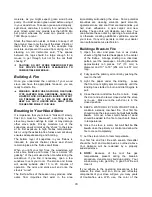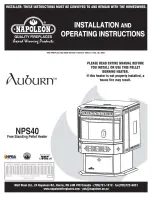
21
soapstone will change and small fractures may
appear on the surface. These changes do not affect
the function of the stove. If a stone breaks
completely, it must be replaced
Avoid the following conditions that can cause the
glass, refractory panels, steel or cast iron pieces to
break:
Do not throw wood into the stove.
Do not use the door as a lever to force wood into
the stove.
Do not load wood encrusted with ice into a
burning stove - the thermal shock can cause
damage.
Do not use a manufactured log grate. Burn the
fire directly on the soapstone lining the cast iron
bottom of the firebox.
Normal Operation
Prior to loading the stove, ensure the ash grate,
refractory soapstone, and the ash pan are in place.
Ensure the ash door is closed to prevent over-firing.
Building a Fire for Everyday Use
1) Open the front door and place five or six double
sheets of tightly twisted newspaper in the center
of the firebox. Arrange kindling in a crisscross
configuration
over
the
newspaper.
Use
approximately 10 pieces of kindling, 1/2" (13
mm) in diameter and 10" to 16" (254 mm to 406
mm) long.
2) Fully open the primary air control by pushing the
lever fully to the left.
3) Light the paper under the kindling. Leave the
front door slightly ajar momentarily until the
kindling begins to burn and draft begins to pull.
4) Close the door and allow the fire to burn.
5) Once the kindling is burning, open the front door
and add logs, small at first, to build the fire up.
Ensure you keep the logs away from the glass in
front in order for the air-wash system to work
properly. Keep the front door and ash door
closed while the stove is in use.
6) Once the fire is burning well, use the primary air
control to regulate the desired rate of burn.
Pushing the lever to the left opens the
PRIMARY AIR CONTROL for a high rate of burn
or pushing it to the right for a low rate of burn.
The air control does not close completely.
Note:
When opening the front door to reload or re-
arrange logs, it is advisable to open the door just a
crack, pause for a moment then open the door
completely. This procedure allows the firebox to
clear of smoke before the door is open fully. In
addition, reloading on a bed of hot, red coals
reduces smoking time and brings fresh fuel up to a
high temperature rapidly.
Burn Rate
HIGH BURN:
500-600 Degrees F. Fully load the
firebox with wood on a bed of hot coals or on an
actively flaming fire and fully open the primary air
control. A high burn rate once or twice a day for 35
to 45 minutes to heat the stovepipe and chimney
fully, will help minimize creosote accumulation.
MEDIUM HIGH BURN:
450-500 Degrees F. With
the primary air control in the fully open position,
push the control lever about ¼ of its travel to the
right.
MEDIUM LOW BURN:
400-450 Degrees F. With the
primary air control in the fully open position, push
the lever about half to two thirds of the way to the
right. A medium-low burn rate is the typical setting
and is preferable if the stove is unattended.
LOW BURN:
Less than 400 Degrees F. Push the
primary air control inward all the way to the right.
This closes the air shutter to its minimum opening. A
low burn rate over extended periods is not advisable
as it can promote the accumulation of creosote.
Inspect the venting system frequently if using low
burn rates consistently.
Over-Fire Caution
Over-firing means the stove is operating at
temperatures above normal temperatures reached
during High Burns outlined in the
BURN RATE
section. Carefully avoid over-firing, as it will damage
the stove. Symptoms of chronic over-firing can
include warped components, short burn times, a
roaring sound in the stove or stovepipe, and
discoloration of the stovepipe. A properly installed
stove using fuel and following operating procedures
as outlined in this manual should not over-fire.
Excessive draft, inappropriate fuel, and operator
error can cause over-firing. Correct an over-fire
situation as follows:
EXCESSIVE DRAFT:
Contact your local dealer
to have a draft reading taken. Any draft in
excess of 0.1 WC requires a damper in the
stovepipe. Some installations may require more
than one damper.
Содержание 8012
Страница 2: ...2 Intentionally Blank ...
Страница 12: ...12 Figure 9 ...
Страница 16: ...16 Figure 13 ...
Страница 28: ...28 Safety Label ...









































